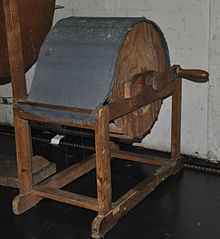Wind machine (musical instrument)

The wind machine (English wind machine or aeoliphone ) is the group of friction idiophone belonging effect instrument , which in music and theater is used for imitation of wind and storm noises. The wind machine usually consists of a horizontally rotating cylinder fitted with brushes, which is driven by a hand crank and which makes a stationary belt made of taffeta or similar material, stretched around the cylinder, vibrate. The volume and, to a limited extent, the pitch can be influenced by varying the rotation speed of the cylinder. In the orchestra the wind machine is part of the percussion , so it is operated by the percussionists.
A well-known example of the use of a wind machine in the symphony orchestra is the tone poem Don Quixote by Richard Strauss , where Don Quixote's air passage is musically staged in the 7th variation. Other usage examples : Don Quixotte (Georg Philipp Telemann) , Les Boréades (Jean-Philippe Rameau), An Alpine Symphony , The Woman Without a Shadow (Richard Strauss), Sinfonia Antartica ( Vaughan Williams ), Daphnis and Chloé ( Ravel ).
See also
literature
- James Blades: Wind machine. In: Grove Music Online, 2001
Web links
- Wind Machine / Aeliophone. Youtube video